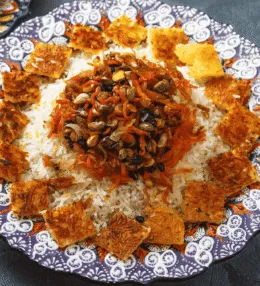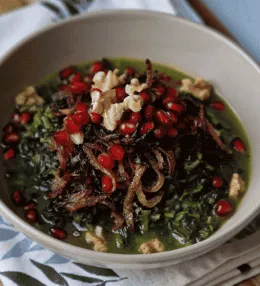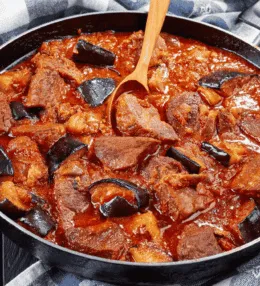
- View
Table of Contents
ToggleThe Cornish pasty has long been a symbol of practical cooking, a meal that was designed for working people yet became a treasured part of Britain’s culinary identity. Its crimped edge and golden crust make it instantly recognisable, but it is the filling inside that defines its character.
Traditionally, it was prepared as a full meal sealed inside pastry, sturdy enough to be carried to the fields or mines. It provided a convenient way to keep meat and vegetables warm, while the thick edge allowed workers to hold it with dirty hands and discard the crust.
Today, the Cornish pasty is found far beyond Cornwall, enjoyed in bakeries and homes across the United Kingdom. It remains a food that feels both practical and comforting, carrying a history that can still be tasted in every bite.
Want to dive deeper into British Cuisine? Don’t miss our post on Traditional British Foods to Try
What Is a Cornish Pasty?
A Cornish pasty is a semi-circular pastry filled with raw meat and vegetables that are sealed and baked until tender. The crimping along the side is distinctive, not only giving it strength but also serving as a mark of authenticity.
Unlike pies, which are often served with cutlery, pasties are meant to be eaten by hand. This portability is part of what made them popular, allowing workers to enjoy a filling meal without the need for a plate or spoon.
The traditional version always contains beef, potatoes, onions, and swede. These are cut into chunks rather than diced too finely, which helps the ingredients hold their texture as they steam together inside the pastry case.
Ingredients and Taste
Beef skirt is the preferred meat, chosen for its flavour and ability to become tender during long cooking. Potatoes provide body, onions bring sweetness, and swede adds an earthy depth. Together, they create a balance of savoury, sweet, and hearty notes.
The pastry is usually shortcrust, made firm enough to withstand handling but not so heavy that it feels tough. As the pasty bakes, the juices from the filling soak gently into the pastry, giving it a richness that is deeply satisfying.
When eaten, each bite delivers warmth and texture. The meat is soft, the vegetables are tender yet distinct, and the pastry adds both crispness on the outside and softness where it meets the filling. It is a simple combination elevated by care and tradition.
A Taste of History
The Cornish pasty has roots that stretch back several centuries, firmly tied to Cornwall’s mining communities. Tin miners often worked long hours underground with little chance to stop for meals, so the pasty became a practical solution to sustain them.
Its thick crimped edge was more than decorative. Miners’ hands were covered in dust and often contaminated by arsenic from the rocks, so the crust acted as a handle. Once the filling was eaten, the edge was discarded, reducing health risks.
Over time, the pasty became closely associated with Cornwall’s identity. Recipes were passed down through families, each household adding subtle variations while staying true to the core ingredients that defined authenticity.
Recognition has since spread well beyond Cornwall. In 2011, the Cornish pasty gained Protected Geographical Indication status within the European Union, ensuring that only those made in Cornwall using traditional methods could carry the name.
Today, it is still baked with pride in Cornish kitchens, yet it has also become a staple across the country. From high street bakeries to family gatherings, the Cornish pasty remains a meal that combines practicality, heritage, and lasting flavour.
How to Make Cornish Pasty (Meat and Veg Pastry)
The Cornish Pasty is a celebrated dish from Cornwall, once carried by miners as a complete meal in a pastry case. Expect tender beef, earthy root vegetables, and a buttery shortcrust folded into its famous D-shape. The key is balance: well-seasoned filling, sturdy pastry, and careful crimping. See the recipe card at the bottom for printable directions
Ingredients
For the pastry
- 500g plain flour
- 250g cold unsalted butter, diced
- 1 tsp salt
- 150ml cold water
For the filling
- 300g beef skirt or chuck steak, finely diced
- 250g waxy potatoes, peeled and diced small
- 150g swede (rutabaga), peeled and diced small
- 1 medium onion, finely chopped
- 1 ½ tsp salt
- 1 tsp freshly ground black pepper
For assembly
- 1 egg, beaten (for glazing)
Cooking Instructions
Step 1: Make the pastry
To begin, sift the flour and salt into a large bowl. Rub in the cold butter with your fingertips until the mixture resembles coarse breadcrumbs. Add cold water gradually, mixing until a firm dough forms. Wrap and chill for 30 minutes.
Step 2: Prepare the filling
Dice the beef, potato, swede, and onion finely and evenly to ensure even cooking. Place in a bowl, season generously with salt and pepper, and mix well with your hands. Transition to rolling the pastry.
Step 3: Roll the pastry
On a floured surface, roll out the chilled pastry to about 5mm thick. Cut into four large circles, around 20cm across. Cover with a clean cloth to prevent drying. Move to filling the pasties.
Step 4: Fill the pasties
Place a quarter of the filling in the centre of each pastry circle. Keep the edges clear to allow sealing. Ensure the layers alternate potato, swede, onion, and beef for traditional structure. Continue to sealing.
Step 5: Seal and crimp
Brush the pastry edges lightly with water. Fold the pastry over the filling to form a half-moon shape. Press edges together firmly, then crimp by twisting and folding along the edge for the classic Cornish look. Transition to glazing.
Step 6: Glaze the pasties
Place pasties on a lined baking tray. Brush the tops with beaten egg for a rich golden crust. Prepare the oven for baking.
Step 7: Bake
Preheat the oven to 200°C (fan 180°C, gas mark 6). Bake the pasties for 20 minutes at this temperature, then reduce to 170°C (fan 150°C, gas mark 3) and bake for another 30–35 minutes until golden and crisp. Proceed to resting.
Step 8: Rest before serving
Remove from the oven and allow to rest for 10 minutes on a wire rack. This helps the filling settle and prevents burns when eaten. Move to serving.
Final Step: Serve
Serve the pasties warm or cold. Traditionally enjoyed without extras, but a side of chutney or pickled onions pairs beautifully. Presentation tip: Wrap in parchment if taking as a packed lunch.
Variations and Substitutions
- Replace beef skirt with chuck or flank steak if unavailable.
- Substitute swede with turnip if preferred.
- For a vegetarian pasty, use mushrooms in place of beef.
- Use ready-made shortcrust pastry if pressed for time.
Cooking Tips for Perfect Cornish Pasty
- Keep butter and water cold when making pastry for a flaky result.
- Dice filling ingredients small and evenly to ensure proper cooking.
- Do not overfill, as the pastry may split during baking.
- Always crimp firmly to prevent juices escaping.

Cornish Pasty (Meat and Veg Pastry)
Ingredients
For the pastry
- 500 g plain flour
- 250 g cold unsalted butter diced
- 1 tsp salt
- 150 ml cold water
For the filling
- 300 g beef skirt or chuck steak finely diced
- 250 g waxy potatoes peeled and diced small
- 150 g swede rutabaga, peeled and diced small
- 1 medium onion finely chopped
- 1 ½ tsp salt
- 1 tsp freshly ground black pepper
For assembly
- 1 egg beaten (for glazing)
Instructions
- To begin, sift the flour and salt into a large bowl. Rub in the cold butter with your fingertips until the mixture resembles coarse breadcrumbs. Add cold water gradually, mixing until a firm dough forms. Wrap and chill for 30 minutes.
- Dice the beef, potato, swede, and onion finely and evenly to ensure even cooking. Place in a bowl, season generously with salt and pepper, and mix well with your hands. Transition to rolling the pastry.
- On a floured surface, roll out the chilled pastry to about 5mm thick. Cut into four large circles, around 20cm across. Cover with a clean cloth to prevent drying. Move to filling the pasties.
- Place a quarter of the filling in the centre of each pastry circle. Keep the edges clear to allow sealing. Ensure the layers alternate potato, swede, onion, and beef for traditional structure. Continue to sealing.
- Brush the pastry edges lightly with water. Fold the pastry over the filling to form a half-moon shape. Press edges together firmly, then crimp by twisting and folding along the edge for the classic Cornish look. Transition to glazing.
- Place pasties on a lined baking tray. Brush the tops with beaten egg for a rich golden crust. Prepare the oven for baking.
- Preheat the oven to 200°C (fan 180°C, gas mark 6). Bake the pasties for 20 minutes at this temperature, then reduce to 170°C (fan 150°C, gas mark 3) and bake for another 30–35 minutes until golden and crisp. Proceed to resting.
- Remove from the oven and allow to rest for 10 minutes on a wire rack. This helps the filling settle and prevents burns when eaten. Move to serving.
- Serve the pasties warm or cold. Traditionally enjoyed without extras, but a side of chutney or pickled onions pairs beautifully. Presentation tip: Wrap in parchment if taking as a packed lunch.
Nutrition
You May Also Like







Leave a Review